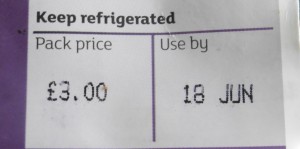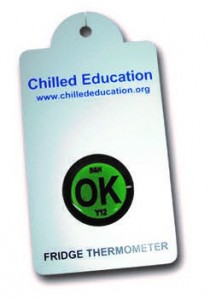How to Handle Chilled Foods at Home
The chilled food industry in the UK is the most advanced in the world. With over 15,000 different chilled prepared foods on the market including chilled prepared fruit and vegetables, salads, soups, sandwiches, pizzas, ready meals and desserts.
Chilled prepared foo ds are ready to eat, ready to reheat or ready to cook and generally use ingredients and cooking methods traditionally found in a normal domestic kitchen.
ds are ready to eat, ready to reheat or ready to cook and generally use ingredients and cooking methods traditionally found in a normal domestic kitchen.
Chilled prepared foods are designed to be stored at refrigeration temperatures below 8oC (optimum 5oC maximum) and need to be kept chilled in a fridge to safely meet their shelf life. If they are not properly chilled and stored, bacteria can multiply.
Buying chilled foods – look for the ‘use by’ date
Chilled foods have a very short life (generally 1-10 days in the UK). This is because they receive very little processing. Strict temperature controls are required throughout the whole food chain to maintain their safety and quality. So when buying chilled prepared foods:
- Look on the l
 abel for the ‘use by’ date. This is the date after which the food should not be consumed as the taste and quality can be affected and potentially the food may be unsafe to eat.
abel for the ‘use by’ date. This is the date after which the food should not be consumed as the taste and quality can be affected and potentially the food may be unsafe to eat. - Buy chilled foods last on your shop. Pack them together ideally in an insulated bag or cool box. Take them home and put them in the fridge as soon as possible.
- Avoid putting chilled foods in warm places during transport e.g. near car heaters or in the sun.
- Check the ‘use by’ dates on the food in your fridge on a regular basis and be sure to use (eat, cook or freeze) food before its ‘use by’ date to help you avoid throwing food away unnecessarily.
How to store chilled foods – temperatures, ‘use by’ dates, ‘eat within’
As with all foods, correct storage is important to reduce the risk of food poisoning.
- Always read the manufacturer’s storage instructions and make sure that you store chilled foods in the fridge at the right temperature until it is time to cook or eat them.
- Always use chilled foods within the ‘use by’ date, but even if a food is within this date don’t eat it if it looks, tastes or smells off.
- Once the packaging is opened it is important to follow any additional instructions, such as ‘eat within two days of opening’, but not if the use by date is tomorrow.
- Do not eat left over cooked chilled food or chilled prepared foods that have been left out at room temperature for more than 3 to 4 hours.
- Avoid cross contamination by storing chilled foods separately from raw foods, such as meat or fish. Raw foods should be kept separate from cooked and ready-to-eat foods and should be placed on the bottom shelf of the fridge so that they don’t drip onto other foods.
- If you freeze chilled prepared foods in the home make sure you follow manufacturers’ instructions. Do not refreeze once defrosted.
Preparation of chilled foods
- Always follow
 the manufacturers’ preparation instructions carefully.
the manufacturers’ preparation instructions carefully. - Keep chilled foods out of the fridge for the shortest time possible during preparation and before cooking. Salads, for example, should be kept in the fridge until they are ready to be eaten.
- Prewashed prepared produce such as salad leaf should not be re-washed as it may become cross-contaminated. See more about fresh produce safety.
- If the food can be frozen at home this will be clearly indicated on the label. Follow manufacturers’ instructions and completely defrost before cooking and eat immediately.
- Proper heating of chilled foods that require cooking is essential to reduce the risk of food poisoning. Follow the label instructions on cooking temperatures and times. If using a conventional oven, remember to preheat the oven properly. Once cooked keep foods covered and piping hot until it is time to eat them.
- When serving chilled prepared food you should minimise the time when it is not refrigerated to a maximum of 4 hours. After this you should no longer eat the food. Keep all foods well covered to protect them from dust, dirt and insects.
Hygiene basics
Bacteria are everywhere – in the air, soil, water and on our food. The bacteria that can cause food poisoning are usually controlled by cooking and chilling our food, but under the right conditions they can multiply and spread around the home, particularly in the kitchen – via our hands, chopping boards, cloths, knives and other utensils.
If bacteria cross contaminate other foods, especially cooked and ready-to-eat foods, they can make us ill. Good kitchen hygiene and good personal hygiene, therefore, are important to help control the spread of harmful germs.
- Keep kitchen surfaces and utensils clean after preparing foods.
- After handling foods always wash your hands, utensils and surfaces thoroughly and before any contact with other food.
- Tea towels can be a source of cross-contamination so use them sparingly. Preferably use disposable cloths or paper towels.
- Keep pets away from kitchen surfaces and food preparation areas.
Hand washing
- Wash hands regularly throughout the day and especially before preparing food or eating.
- Wash your hands after handling raw foods and before touching any other food or utensil.
- Always wash your hands after going to the toilet, touching rubbish or waste bins, changing nappies, caring for the sick, coughing or sneezing, handling and stroking pets or farm animals, gardening (even if you wear gloves), and cleaning cat litter boxes. How you wash your hands is very important as we often miss areas. The blue parts of these diagrams show areas of the hands most frequently missed when washing.
Areas on back and palm of hand most frequently missed when washing
The best way to wash your hands is to:
- Wet your hands with water at a comfortable temperature
- Add soap
- Rub hands together vigorously for at least 20 seconds, making sure both sides of the hands are washed fully, around the thumbs and between the fingers and around and under nails
- Rinse with clean water
- Dry with a clean (preferably disposable or paper) towel
Fridge hygiene
- Don’t overload your fridge. If a fridge is over-packed with food or iced up it is harder to keep the temperature low.

- Make sure your fridge stays clean and in good working condition.
- Check regularly (once a week) that your fridge is cold enough i.e. no more than 5oC.
- Use a thermometer to check fridge temperatures. The coldest part of the fridge should be 0-5oC.
- Clean all internal and external surfaces often, especially fridge shelves and door storage compartments. Mop up spills as soon as they happen.
- Defrost your fridge regularly
- Use up older items first – first in first out.
- Following usage instructions will help you save on waste.
More information?
Food Safety Week on Facebook
